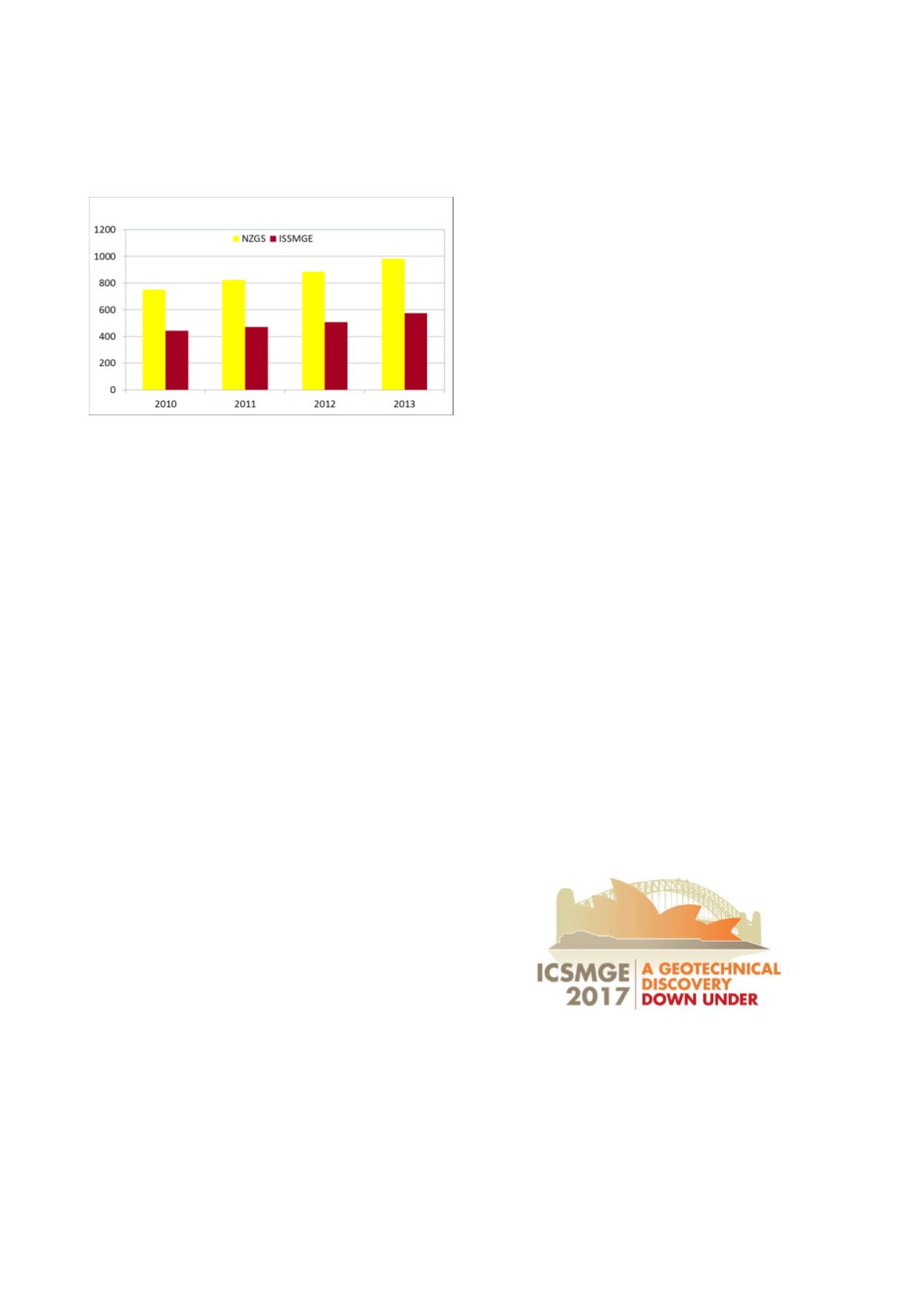

Proceedings of the 18
th
International Conference on Soil Mechanics and Geotechnical Engineering, Paris 2013
1,743 (1,276 in 2009); of these members 1,033 (800 in 2009)
are affiliated to ISSMGE, Figure 2. This represents a growth of
29% in ISSMGE membership since 2009. The NZGS now has a
membership of 982 (731 in 2009) of whom 575 (421 in 2009)
are ISSMGE members, Figure 3. The increase in ISSMGE
membership being 37% over the period 2009-2013.
Figure 3. New Zealand Geotechnical Society - membership
In October 2011 Sam MacKenzie was elected as AGS
National Chair and Darren Paul as Vice Chair & Treasurer.
Since 2009 Professor Mark Jaksa has served on the National
Committee as AGS Liaison Officer for the ISSMGE and he will
be succeeding me as ISSMGE Vice-President for Australasia. In
2011 David Burns became Chair of the NZGS Management
Committee with Gavin Alexander as Vice-Chair & Treasure. In
2012 Gavin Alexander succeeded as the Chair with Charlie
Price becoming the Vice-Chair & Treasurer.
ISSMGE members from the region serve on many of the
ISSMGE Technical Committees and the ANZ hosts two TCs,
viz. Physical Modelling (TC104) and Geo Education (TC306).
These two TCs are chaired by Professor Christophe Gaudin and
Professor Mark Jaksa, respectively. Members of AGS also serve
as officers of TCs, i.e. Professor David White (Secretary of
TC104) and Professor Mark Randolph (Vice Chair of TC209).
Dr Elisabeth Bowman of the NZGS is the Secretary of TC208
(Slope Stability).
2
ACTIVITIES
The Australian Geomechanics Society and the New Zealand
Geotechnical Society are both highly vibrant member societies
of the ISSMGE. Because of the geographical spread of their
membership both societies organise their activities through
Chapters (AGS) or Branches (NZGS). In addition to regular
technical meetings both societies have a very active
programmes of special events, as can be seen in the appendices
to this report. These include Young Geotechnical Professional
activities, specialist seminars and lectures from distinguished
speakers. In addition, both societies have a number of prizes and
awards to recognise the achievements of their members.
Australian Geomechanics
is the “official” journal of the
AGS, which is published quarterly, in March, June, September
and December, by the Institution of Engineers Australia. It is
edited and produced by the Australian Geomechanics Society
and is distributed to all members of the AGS. Over the last few
years
Australian Geomechanics
has published special issues
concentrating on the geotechnics in regions of the country
together with a special issue (in June 2011) on Landslide risk
management (see Appendix A). The New Zealand Geotechnical
Society publishes a biannual bulletin,
Geomechanics News
, for
its members in June and December of each year. Each issue of
the bulletin publishes special features (see Appendix B) most
notable of these in the period of this report is the June 2011
issue, which contained a series of articles about the February
2011 Christchurch earthquake sequence.
In addition to the regular publications produced by AGS and
NZGS both societies also publish technical guides. Whilst the
NZGS has been involved in developing geotechnical earthquake
engineering advice for many years the Christchurch earthquake
sequence has increased the requirement for this and the NZGS
has responded by accelerating the process of preparing a series
of Modules for its Seismic Design Guidelines series.
The member societies in the Australasia region have
continued during the last presidential period to organise and
sponsor a significant number of seminars, symposia and
conferences. These are detailed in the appendices. Most notable
of these was the ISSMGE Australasia regional conference,
ANZ 2012, held in Melbourne during July 2012. This
conference, which attracted 558 delegates from around the
world, was universally acclaimed as a great success both from
its technical content and the standard of organisation. This
demonstrated that the AGS was not only capable of organising a
world class conference but it could also attract delegated to it
from around the globe.
There are a number of major ISSMGE conferences being
planned to be held in the region in the next few years. The 5th
International Conference on Earthquake Geotechnical
Engineering (TC203) to be held in Christchurch, New Zealand
in 2015. Four ISSMGE conferences will be taking place in
Australia: 8th International Conference on Physical Modelling
in Geotechnics (TC104), Perth 2014; 7th International Congress
on Environmental Geotechnics (TC215), Melbourne 2014; 6th
International Conference on Unsaturated Soils (TC106),
Brisbane 2014; 5th International Conference on In-situ Testing
and Geophysical Characterisation (TC102), Brisbane 2016.
Having demonstrated its ability to host a major international
conference the AGS formed a committee, headed by former
AGS Chair Graham Scholey, which prepared a very strong bid
to host the 19th Conference of the International Society for Soil
Mechanics and Geotechnical Engineering (ICSMGE) in Sydney
during September 2017, Figure 4. Despite the strong support for
the ISSMGE in Australia and New Zealand the ICSMGE has
not been held in the Australasia region in the history of the
Society. In the hope of redressing this anomaly the AGS bid for
the 19
th
ICSMGE was supported strongly by the NZGS.
However, in the vote taken at the Paris council meeting the
AGS bid lost out to the proposal from South Korea and the 19
th
ICSMGE is to be held in Seoul in 2017. Although very
disappointed by the result of the vote, the AGS has indicated
that it wishes to bid to host the 20
th
ICSMGE.
Figure 4. Logo for AGS bid to host the 19
th
ICSMGE
As will be seen from this report, although the ISSMGE
Australasia region has only two member societies, the high
quality of research and practice in geotechnical engineering in
the region together with the energy of the membership and
management committees of the AGS and the NZGS result in the
region being highly active. It is, therefore, exceptionally
pleasing that one of the two societies, the NZGS, has been
Volume 6 - Page 266









